Document WG1N72005
JPEG Initiates Standardization of Plenoptic Image Coding System - JPEG Pleno
JPEG Pleno - Tremendous progress has been achieved in the way consumers and professionals capture, store, distribute, render, display and ultimately use images. We have been witnessing an ever-growing acceleration in creation and usage of images in all sectors, applications, products and services. During the past 25 years, the Joint Photographic Experts Group (JPEG) has been an example of such efforts, and it has offered image coding standards which can cope with imaging challenges.
Digital photography markets have known a steady – somewhat linear – evolution over the last decade with regards to supported resolutions, following Moore’s law. However, we have reached the era of nanoelectronics and we are presently observing the maturing of micro- and nanophotonics technologies giving rise to an unprecedented and heterogeneous range of new digital imaging devices.
VR/360 and depth imaging systems, HDR and 3D image sensors, burst-mode cameras, light field sensing devices, camera arrays, point cloud scanners, holographic microscopes enable new capture and visualization systems that are resulting in a paradigm shift in the consumption of digital photographic material. This paradigm shift will be as disruptive for the photographic markets as the migration from analog film to digital pictures.
JPEG PLENO targets a standard framework for capture, representation, and exchange of new imaging modalities such as VR/360, depth enhanced, light field, point cloud and holographic imaging. Additionally, it also targets defining new tools for improved compression while providing additional advanced functionality and support for - but not limited to - image manipulation, metadata, image access and interaction, privacy and security.
A Call for Proposals has been issued and the JPEG committee invites interested parties to contribute to this standardisation activity.
In preparation of this activity a report has been created jointly by JPEG and MPEG to summarize the state of the art in light and sound fields digital representations and to give an outlook on future workflows based on these technologies. The “Technical report of the joint ad hoc group for digital representations of light/sound fields for immersive media applications” is available on the JPEG website.
JPEG XS - Today’s industrial applications often imply transport and storage of uncompressed images and video. This is for instance the case in video links (SMPTE Serial Digital Interface), IP transport (SMPTE ST 2022 5/6 & proprietary uncompressed RTPs), Ethernet transport (IEEE/AVB), proprietary transports, memory buffers, and omnidirectional video capture and rendering in VR applications. In this context, the JPEG committee has started a new standardization project, JPEG XS, referenced as ISO/IEC 21122, that targets a low-latency lightweight coding system aimed at supporting higher resolutions and frame rates over these channels assuring high visual quality and low latency while keeping power and bandwidth consumption within a reasonable budget. This effort will result in a highly interoperable solution.
In response to the Call for Proposals released by the JPEG committee in March 2016, seven proponents submitted technologies to contribute to the upcoming standard. During the 72nd WG1 meeting in Geneva (CH), overviews of proposed technologies were presented and the JPEG XS proposals evaluation process was defined. The results of this evaluation will be reviewed during the next WG1 meeting in Chengdu (CN), and will lead to the selection of technologies in order to create the foundational technologies for the upcoming standard. Interested parties, in particular coding experts, codec providers, system integrators and potential users of foreseen solutions are invited to contribute to this standardization process.
JPEG AIC - This project provides procedures for the evaluation of high dynamic range content and image sequences, in particular for low impairment, nearly lossless coding systems. This field of coding is becoming increasingly important by virtue of low cost designs that offer combined real time coding, low latency and high quality for lightly compressed bit streams such as JPEG XS. New procedures are expected to be included in the ISO/IEC 29170-2 standard by 2017.
JPEG Privacy & Security - The JPEG committee is exploring the standardization of one or more solutions to assure privacy and security when sharing photos on social networks, (stock) photography databases, etc. JPEG Privacy & Security will provide new functionality to JPEG encoded images such as ensuring privacy, maintaining data integrity, and protecting intellectual property rights, while maintaining backward and forward compatibility with existing JPEG legacy solutions. To collect input from interested parties in this field, a third public workshop on JPEG Privacy & Security is being organized to take place on October 18th, 2016 during the next JPEG meeting in Chengdu, China. Additional information for the workshop is available on JPEG website.
"JPEG Pleno and JPEG XS both open new paradigms in image compression technologies and have the potential to impact future imaging products and services the same way legacy JPEG file format did two decades ago." said Prof. Touradj Ebrahimi, the Convener of the JPEG committee.
About JPEG
The Joint Photographic Experts Group (JPEG) is a Working Group of ISO/IEC, the International Organisation for Standardization / International Electrotechnical Commission, (ISO/IEC JTC 1/SC 29/WG 1) and of the International Telecommunication Union (ITU-T SG16), responsible for the popular JBIG, JPEG, JPEG 2000, JPEG XR, JPSearch and more recently, the JPEG XT, JPEG XS and JPEG Systems families of imaging standards.
The WG1 group meets nominally three times a year, in Europe, North America and Asia. The latest 72nd meeting was held on May 30 - June 3, 2016 in Geneva, Switzerland and was hosted by UTU-T. The next (73rd) WG 1 Meeting will be held on October 17-21, 2016, in Chengdu, China.
More information about JPEG and its work is available at www.jpeg.org or by contacting Peter Schelkens and Fumitaka Ono of the JPEG PR subgroup at .
If you would like to stay posted on JPEG activities, please subscribe to the jpeg-news mailing list.
